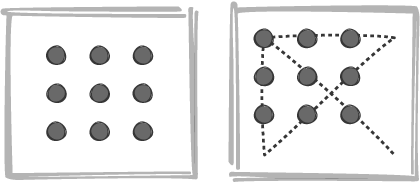5.3. Thinking in and out of boxes is OK
The second most notorious and misleading phrase regarding ideas, "think outside of the box," has its origins in a classic brainteaser-type puzzle. The puzzle, shown in Figure 5-4, asks the puzzle victim, I mean participant, to connect all nine dots using only four straight lines—without lifting the pen off the paper. It turns out that this is impossible, unless the victim uses the space beyond the boundaries of the dots and thinks (drum roll please) outside of the box. The point is supposed to be that by erroneously assuming that constraints and boundaries are part of a problem, we limit our thinking and prevent ourselves from finding solutions. It's a charming, almost sweet, point, and I'll give you a moment to savor it before I tear it to shreds.
Puzzles and brainteasers aside, it's not eliminating boxes that is most difficult—it's knowing which boxes to use and when to use them. Constraints are ever present: we require air to breathe and food to live. The laws of physics bind objects together. Sometimes, constraints are helpful in solving problems; for example, say what you will about gravity, but I'm grateful that I can assume when I put a pointy rock down on the ground, it's not going to fly up and hit me in the face.
Figure 5-4. The "think outside of the box" puzzle, with solution.

Thus, the real craft of problem solving and creative ...
Get The Art of Project Management now with the O’Reilly learning platform.
O’Reilly members experience books, live events, courses curated by job role, and more from O’Reilly and nearly 200 top publishers.

